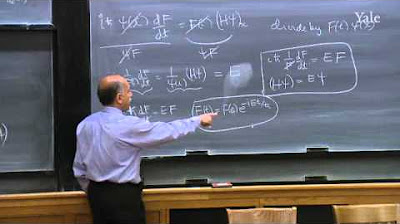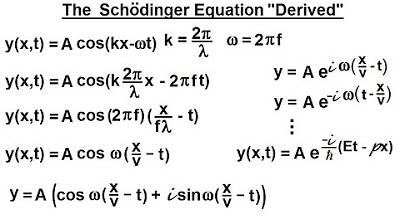26.1 Integral Equations for Quantum Bound States
TLDRThis script discusses the final chapter on integral equations in quantum mechanics, focusing on their application to bound states and scattering problems in momentum space. It explains the transition from the Schrödinger equation with a non-local potential to an integral equation in momentum space, simplifying the problem. The lecture covers the theory, numerical methods like Gaussian quadrature, and solving for eigenvalues and eigenvectors. It also introduces the delta shell potential as an example, providing insights into numerical precision and the importance of checking solutions for physical plausibility.
Takeaways
- 📚 The lecture discusses Chapter 20 on integral equations in quantum mechanics, focusing on their application to bound states and scattering problems.
- 🧠 Integral equations are presented as an alternative to differential equations for solving quantum mechanics problems, particularly useful in momentum space.
- 🔍 The script delves into the concept of non-local potentials, which depend on the wave function at all points in space, not just at a single point.
- 🔑 The transition from coordinate space to momentum space simplifies the integral differential equation into a simpler integral equation, facilitating numerical solutions.
- 📉 The script introduces the delta shell potential as a model problem with an analytic solution, useful for verifying numerical methods.
- 📈 Gaussian quadrature is recommended for numerical integration due to its precision and reliability in solving integral equations.
- 🔍 The process of solving the integral equation involves discretizing the integral into a sum over grid points, leading to a set of simultaneous linear equations.
- 🔢 The script explains the use of matrix techniques to solve the eigenvalue problem associated with the Schrödinger equation in momentum space.
- 💡 The determinant of the Hamiltonian matrix minus the energy must be zero for bound state solutions to exist, providing a condition for finding eigenvalues.
- 📉 The lecture provides a step-by-step guide on setting up and solving the Schrödinger equation in momentum space, including code examples in Python.
- 📊 The importance of checking the results by comparing the left and right-hand sides of the Schrödinger equation is emphasized for validation of the numerical solutions.
Q & A
What is the main topic of Chapter 20 in the book?
-The main topic of Chapter 20 is integral equations in quantum mechanics, with a focus on both electron integral equations and their application in solving quantum mechanical problems.
Why is it important to solve integral equations in quantum mechanics?
-Solving integral equations in quantum mechanics is important because it allows for the numerical solution of problems on computers, which is particularly useful for many-body systems where the potential is non-local and effective, rather than fundamental.
What are the two parts of the integral equations in quantum mechanics discussed in the script?
-The two parts discussed are part one, which covers bound states and is considered the undergraduate level, and part two, which is about scattering and is considered more advanced, involving graduate-level numerical aspects.
Why is it necessary to work in momentum space for many-body systems in quantum mechanics?
-Working in momentum space is necessary for many-body systems because the potential experienced by a particle in such a system is non-local and depends on the wave function at all points in space, not just at a single point.
What is the significance of the Schrödinger equation with a non-local potential?
-The Schrödinger equation with a non-local potential is significant because it describes the interaction of a particle with an effective potential that depends on the wave function at all points in space, making it a complex equation that combines both differential and integral aspects.
How does the script suggest solving the integral equation for bound states in quantum mechanics?
-The script suggests solving the integral equation for bound states by converting the integral differential equation into momentum space, which simplifies it to an integral equation that can be solved using matrix techniques and numerical methods such as Gaussian quadrature.
What is the role of the Hamiltonian matrix in solving the integral equation in quantum mechanics?
-The Hamiltonian matrix represents the sum of the kinetic and potential energies in the Schrödinger equation. It is used to set up a system of simultaneous linear equations that can be solved to find the eigenvalues (energies) and eigenvectors (wave functions) of the system.
Why is the determinant of the Hamiltonian matrix set to zero to find the eigenvalues?
-Setting the determinant of the Hamiltonian matrix to zero is a condition for finding the eigenvalues because it indicates that the inverse of the matrix does not exist, which is necessary for non-trivial solutions to the Schrödinger equation.
What is the delta shell potential mentioned in the script, and why is it used as an example?
-The delta shell potential is a model potential where particles interact only when they are at a certain distance apart. It is used as an example because it has analytic solutions for both bound states and scattering, allowing for the verification of numerical methods.
How can one verify the accuracy of the numerical solutions obtained for the bound states in quantum mechanics?
-One can verify the accuracy of numerical solutions by comparing the computed energies and wave functions with known analytic solutions, if available, or by checking the stability of the solutions as the number of integration points increases.
Outlines
🚀 Introduction to Quantum Mechanics and Integral Equations
The script begins with an introduction to the final chapter on integral equations in quantum mechanics, emphasizing the significance of understanding both electron integral equations and their applications in quantum mechanics. The chapter is divided into two parts: the first covers bound states, which is fundamental, and the second, scattering, which is more advanced and optional. The lecturer explains the concept of effective non-local potentials in many-body systems and introduces the Schrödinger equation with a non-local potential, highlighting the complexity of solving for bound states in quantum mechanics.
🔍 Solving Bound State Problems in Momentum Space
This paragraph delves into the specifics of solving bound state problems in quantum mechanics, particularly in momentum space. The lecturer discusses the theoretical framework based on the Schrödinger equation in momentum space, contrasting it with the coordinate space approach. The importance of dealing with many-body systems and the use of momentum space for complex problems are highlighted. The paragraph also covers the process of converting the integral differential equation into a simpler integral equation in momentum space and introduces the concept of potential and wave function transformations to momentum space.
📚 Numerical Methods for Solving Integral Equations
The script explains the numerical approach to solving integral equations by converting them into a set of simultaneous linear equations. The use of Gaussian quadrature for integration is recommended for its reliability. The process involves replacing the integral with a sum over integration points, leading to an algebraic equation that can be solved using matrix techniques. The讲师 discusses the challenges of solving these equations, including the unknown wave function and energy, and the need to solve for these at specific grid points.
🔑 The Schrödinger Equation as a Matrix Problem
This section describes the transformation of the Schrödinger equation into a matrix form, facilitating the solution of the integral equation using linear algebra techniques. The Hamiltonian matrix is defined, and the讲师 explains how the wave function and energy can be found by solving this matrix equation. The paragraph also introduces the concept of eigenvalue problems and how they relate to finding the energy levels of the quantum system.
🔍 Bound State Condition and Mathematical Solutions
The lecturer discusses the bound state condition, which is necessary for the existence of non-trivial solutions to the Schrödinger equation. This condition is met when the determinant of the Hamiltonian matrix minus the energy is zero. The paragraph explores the mathematical implications of this condition and how it can be used to solve for the eigenvalues, which represent the energy levels of the system.
🌟 The Delta Shell Potential Model
The script introduces a specific model potential, the delta shell potential, which is used for illustrative purposes due to its analytical solutions for both bound states and scattering. The delta shell potential is characterized by an infinitely strong interaction at a specific distance, and the lecturer discusses its properties and the challenges it presents in numerical calculations.
🛠️ Implementing Numerical Solutions for the Delta Shell Potential
The lecturer provides guidance on implementing numerical solutions for the delta shell potential problem. The use of matrix algebra routines is suggested, and the讲师 outlines the steps for setting up the Hamiltonian matrix, including potential and kinetic energy terms. The paragraph discusses the process of finding eigenvalues and eigenvectors, which correspond to the energy levels and wave functions of the system.
📉 Analyzing the Results and Precision Estimation
This section advises on how to analyze the results obtained from the numerical solutions, emphasizing the importance of estimating the precision of the eigenvalues. The讲师 suggests using the stability of the eigenvalues as the number of grid points increases as a measure of their validity. The paragraph also discusses the potential for numerical artifacts and the need to differentiate between true eigenvalues and noise.
🌌 Exploring Momentum Space Wave Functions
The final paragraph encourages exploring the momentum space wave functions to gain an intuitive understanding of bound states in quantum mechanics. The讲师 outlines the process for determining the momentum space wave function and transforming it back to coordinate space for analysis. The importance of normalization and the expected behavior of wave functions in both spaces are discussed, with a specific focus on the delta shell potential's wave function characteristics.
Mindmap
Keywords
💡Integral Equations
💡Quantum Mechanics
💡Bound States
💡Momentum Space
💡Non-Local Potential
💡Schrodinger Equation
💡Gaussian Quadrature
💡Eigenvalue Problem
💡Matrix Algebra
💡Delta Shell Potential
Highlights
Introduction to the final chapter on integral equations in quantum mechanics.
Explanation of integral equations' importance in solving quantum mechanical problems numerically.
Distinction between electron integral equations and differential equations in quantum mechanics.
Overview of the two parts of the chapter: bound states and scattering in quantum mechanics.
The concept of effective non-local potentials in many-body systems.
Description of the Schrödinger equation with a non-local potential.
Transition from coordinate space to momentum space in quantum mechanics.
Simplification of the integral differential equation to an integral equation in momentum space.
Conversion of the Schrödinger equation to a matrix form in momentum space.
Discussion on the potential's momentum representation through Fourier transforms.
Method to solve the integral equation using Gaussian quadrature points.
Transformation of the integral equation into a set of simultaneous linear equations.
Identification of the need for an additional equation to solve for energy in the eigenvalue problem.
Condition for bound state solutions: the determinant of the Hamiltonian matrix must be zero.
Application of matrix algebra routines to solve for eigenvalues and eigenvectors.
Introduction of the delta shell potential as a model problem with analytic solutions.
Challenges in numerically solving the integral equation due to slow decay of the delta shell potential.
The procedure for checking the accuracy of numerical solutions against analytic forms.
Optional exercise to determine the momentum space wave function and its properties.
Transcripts
Browse More Related Video

26.3 Integral Equations for Quantum Scattering

9.1 Quantum Bound Eigenstates

24. Quantum Mechanics VI: Time-dependent Schrödinger Equation

Ch 7: How are observables operators? | Maths of Quantum Mechanics

Lecture 11: Dispersion of the Gaussian and the Finite Well

Physics - Ch 66 Ch 4 Quantum Mechanics: Schrodinger Eqn (4 of 92) The Schrodinger Eqn. "Derived"
5.0 / 5 (0 votes)
Thanks for rating: